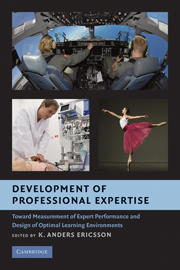 Development of Professional Expertise
Development of Professional Expertise Book contents
- Frontmatter
- Contents
- List of Figures
- List of Tables
- List of Contributors
- 1 The Measurement and Development of Professional Performance: An Introduction to the Topic and a Background to the Design and Origin of This Book
- SECTION 1 CHALLENGES IN PAST AND CONTEMPORARY EFFORTS TO MEASURE AND TRAIN THE OBJECTIVE PERFORMANCE OF PROFESSIONALS
- SECTION 2 PAST AND CONTEMPORARY EFFORTS TO DESIGN INSTRUCTION, TRAIN, AND MAINTAIN PROFESSIONAL PERFORMANCE
- SECTION 3 THE ASSESSMENT AND TRAINING OF SKILLED AND EXPERT PERFORMERS IN THE MILITARY
- 10 Toward a Second Training Revolution: Promise and Pitfalls of Digital Experiential Learning
- 11 Evaluating Pilot Performance
- 12 Contrasting Submarine Specialty Training: Sonar and Fire Control
- 13 Training Complex Cognitive Skills: A Theme-Based Approach to the Development of Battlefield Skills
- 14 Structuring the Conditions of Training to Achieve Elite Performance: Reflections on Elite Training Programs and Related Themes in Chapters 10–13
- SECTION 4 THE DEVELOPMENT OF EXPERTISE AND EXPERT PERFORMANCE
- Name Index
- Subject Index
- References
11 - Evaluating Pilot Performance
Published online by Cambridge University Press: 04 August 2010
- Frontmatter
- Contents
- List of Figures
- List of Tables
- List of Contributors
- 1 The Measurement and Development of Professional Performance: An Introduction to the Topic and a Background to the Design and Origin of This Book
- SECTION 1 CHALLENGES IN PAST AND CONTEMPORARY EFFORTS TO MEASURE AND TRAIN THE OBJECTIVE PERFORMANCE OF PROFESSIONALS
- SECTION 2 PAST AND CONTEMPORARY EFFORTS TO DESIGN INSTRUCTION, TRAIN, AND MAINTAIN PROFESSIONAL PERFORMANCE
- SECTION 3 THE ASSESSMENT AND TRAINING OF SKILLED AND EXPERT PERFORMERS IN THE MILITARY
- 10 Toward a Second Training Revolution: Promise and Pitfalls of Digital Experiential Learning
- 11 Evaluating Pilot Performance
- 12 Contrasting Submarine Specialty Training: Sonar and Fire Control
- 13 Training Complex Cognitive Skills: A Theme-Based Approach to the Development of Battlefield Skills
- 14 Structuring the Conditions of Training to Achieve Elite Performance: Reflections on Elite Training Programs and Related Themes in Chapters 10–13
- SECTION 4 THE DEVELOPMENT OF EXPERTISE AND EXPERT PERFORMANCE
- Name Index
- Subject Index
- References
Summary
Piloting an aircraft, especially in combat situations, requires a high level of performance. Air combat tactics involve dynamic, four-dimensional (x, y, z, and timing) maneuvering and positioning of the aircraft; done at high speed, often approaching or surpassing supersonic speed. Physical and cognitive capabilities and resources are frequently put to the test during flight. Poor performance in wartime can lead to death. Even peacetime military operations and civilian aviation are not incident or accident free. To best prepare our pilots, an understanding of their knowledge, skill competencies, and deficiencies is necessary. In order to accomplish this objective, their performance must be measured and their training progress tracked on various skills using objective outcome measures in both the training environment and in live-range exercises.
In many fields the benefits of task-specific and experiential training are beginning to experience investigation and consideration, with an integration of training and historically conventional methods of education (Boshuizen, Chapter 17; Ericsson, Chapter 18; Lajoie, Chapter 3; Schraagen, Chapter 7). This is not the case with the field of aviation, where the importance of task-specific training has been realized since the initiation of manned flight. As technologies within the aviation industry increased in complexity and sophistication over the past century, so did the demand for training and measuring pilot proficiency. This growing demand was the impetus for the development in flight simulation, within both the military and commercial industries.
Information
- Type
- Chapter
- Information
- Development of Professional ExpertiseToward Measurement of Expert Performance and Design of Optimal Learning Environments, pp. 247 - 270Publisher: Cambridge University PressPrint publication year: 2009
References
Accessibility standard: Unknown
Why this information is here
This section outlines the accessibility features of this content - including support for screen readers, full keyboard navigation and high-contrast display options. This may not be relevant for you.Accessibility Information
- 4
- Cited by